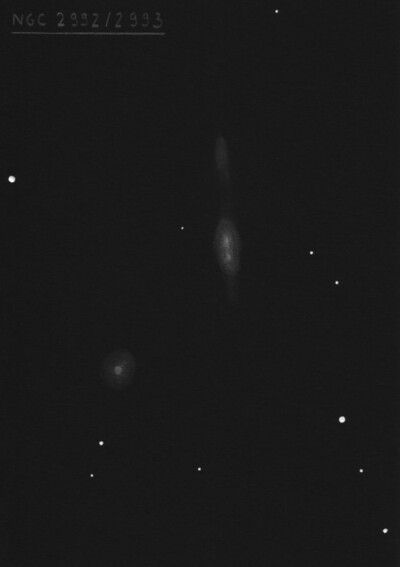
William Herschel discovered NGC 2992 = H III-277 = h635 on 8 Feb 1785 (sweep 371) and recorded "Two [along with NGC 2993], vF, stellar, the most north and preceding [NGC 2992] is the largest. 240x showed the same. Distance 3 or 4'. The place is that of the preceding." His position was ~45 seconds of RA too large (perhaps only recorded to the nearest min). John Herschel measured an accurate position on 16 Dec 1827 (sweep 111) and noted "Not vF; R; bM; 30"." Bindon Stoney noted a mottled appearance with LdR's 72" in 1852.
300/350mm - 13.1" (3/24/84): moderately bright, small, slightly elongated SSW-NNE, bright core. Forms an interacting pair with NGC 2993 2.9' SE.
13.1" (3/3/84): fairly faint, small, roundish, small brighter core.
900/1200mm - 48" (2/19/12): this disrupted galaxy is sharply concentrated with a very bright central region that is elongated ~5:2 SSW-NNE, ~1.0'x0.4'. The central region is well concentrated with an intense core that brightens to a brilliant nucleus.
I initially noted a faint arm extending 30" SSW of the central region but on a second eyepiece look I noticed this arm is twice that length, though the surface brightness is quite low in the outer portion. A long, brighter tidal arm stretches 2' NNE, placing the central region off-center along the 3.5' major axis. This arm or tail has a low surface brightness though brightens in a patch at the NNE end (2.2' NNE of center). A 2000 multi-wavelength study in AJ,120, 1238 concludes this patch (identified as Arp 245N in NED) is a tidal dwarf galaxy still in the process of formation. The western edge of the arm has a subtle curvature. With averted vision, extremely low surface brightness haze forms a bridge extending southeast from the core of NGC 2992 towards NGC 2993 (3' between centers).
Notes by Steve Gottlieb